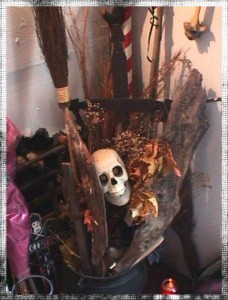 Babies’ skin just isn’t as smooth and clear as the advertisements say it is. Almost every baby develops a fine pink or red rash whenever the skin is irritated by rubbing on bedclothes, by spitting up, or by very hot weather. Almost all of these fine pink rashes will go away promptly if the skin is bathed with clean water whenever it is dirty, and washed with mild soap once a day.
Babies’ skin just isn’t as smooth and clear as the advertisements say it is. Almost every baby develops a fine pink or red rash whenever the skin is irritated by rubbing on bedclothes, by spitting up, or by very hot weather. Almost all of these fine pink rashes will go away promptly if the skin is bathed with clean water whenever it is dirty, and washed with mild soap once a day.
Many babies develop waxy scabs on the scalp and forehead, called “cradle cap” or “seborrhea.” Daily scrubbing with mild soap and a wash cloth will usually keep this under control.
Small, red, blotchy “birthmarks” on the eyelids and back of the neck are so common that they are called “stork bites.” They usually show up when the baby is between 1 and 4 weeks old. They go away by themselves after a year or so, and cause no trouble of any kind. There is nothing to do but wait.
Bright red raised “strawberry marks” are also quite common. They appear after one or two months, grow rapidly for a few months, stop growing and gradually disappear. Unless your baby has one that is particularly large or in a spot where it is constantly being irritated, it is best to let it go away by itself.
Large areas of pale blue discoloration, called “mongolianspots” are common, especially on the trunk of dark skinned infants. They become less obvious as the child grows older and have no importance.
Diaper Rash—Urine and bowel movements are irritating to the skin, especially when they stay in contact with the skin for a long time.
Prevent diaper rash by changing diapers frequently, by rinsing the diaper area with clean water at each diaper change, by rinsing diapers thoroughly after washing, and by applying a layer of zinc oxide paste (you can buy it at any drug store) to any irritated area.
If your baby gets a diaper rash in spite of this, you should:
* Leave off the plastic pants (or plastic covered disposable diapers) except when absolutely necessary. Using 2 or more cloth diapers at nap time and at night will make this less messy.
* Leave the diaper area completely uncovered for a few hours each day (nap time or early evening is most convenient); put a couple of diapers under the baby to prevent soiling.
* Apply a thin layer of zinc oxide paste to any irritated area after cleansing at each diaper change.
When to Worry—Any pimple or rash that gets bright red and enlarges, or that develops blisters or pus, may be the beginning of an infection that will need medical care. You can soak such a rash with a washcloth or towel wrung out in warm water, and keep it clean by washing with mild soap and water twice a day. If it gets worse, or if it doesn’t get better in 24 to 48 hours, you should get medical advice.
Any rash that looks like bleeding or bruising in the skin should be seen by a doctor promptly (unless you know it really is a group of bruises).
Legs and Feet
Most babies’ legs and feet don’t look “normal” until the child has been walking for several years! The feet seem to turn in or out in the first year of life. By age 12 to 18 months the legs look bowed.
Almost all of these funny-looking feet and legs are perfectly normal and will gradually straighten out as babies run, play and climb. If you can move the foot easily into a “normal” looking position, and if the foot moves freely when the baby kicks and struggles, it is almost certainly a normal foot that developed a bend or twist while the baby was sitting on it during your pregnancy.
You won’t cause bowed legs by pulling your baby into a standing position or letting your baby walk or stand “too early.” Also, babies won’t walk any sooner by being placed in a walker—which usually isn’t much fun for babies anyway.
Umbilical Hernia—Swollen Navel
About one-fourth of all babies develop a swelling at the navel. This usually grows rapidly for several months, then grows with the baby for several months, then gets smaller and disappears. Large hernias may not go away until the child is 4 to 6 years old. The bulge often gets tight or tense when the baby cries or coughs.
Since these hernias almost always go away if they are left alone for long enough, there is no reason to have them repaired by surgery. They almost never cause any kind of trouble or pain. Occasionally a 4- to 6-year-old child may be embarrassed by a particularly large hernia, and it can be repaired at that time. By waiting, you will almost certainly save your baby an unpleasant and unnecessary operation.
Genitals
The boy’s penis and scrotum and the girl’s clitoris and labia are usually rather large at birth. They get slightly smaller over the next few weeks.
A girl may have a slight white creamy discharge from her vagina in the first few weeks, which is normal. It should become less and less and should not irritate the skin. Get medical advice if it becomes worse or if she develops a discharge after the first week or two. Any bulge or lump in a girl’s genitals should be checked by a doctor.
One or both of a boy’s testicles may seem particularly large, and be surrounded by a water sac or “hydrocele.” Hydroceles are painless, cause no harm and go away without treatment, usually within a few months. Seek medical care for any swelling in the groin, and seek medical care immediately for any painful swelling in the groin or testicles.
If you want your boy circumcised, have it done while you are still in the hospital. It is not necessary, and it should almost never be done as a special operation once you and he have left the hospital (except for religious circumcisions).
A circumcision should heal completely within a week to 10 days. The tip of a circumcised boy’s penis may become irritated by the diaper. Put a little vaseline or zinc oxide paste on the irritated area each time you change the diaper.
If your boy is not circumcised, don’t try to pull the skin back over the tip of the penis. It will hurt and irritate. As he grows the skin will gradually loosen until it will pull back with ease (it sometimes takes as long as 3 or 4 years).
Sucking
Most babies get their thumbs and fingers in their mouths and suck on them. Many seem to find it especially enjoyable and do it often. It causes no harm and can be ignored.
Some parents don’t like the looks of thumb and finger sucking and substitute a pacifier for the thumb. This also is fine and the pacifier can be thrown away toward the end of the first year. But don’t substitute the pacifier for the attention, food or diaper changes that your baby wants and needs when he or she is crying! And don’t use a bottle of formula or juice as a pacifier!
Crossed Eyes
When awake and alert, your baby’s eyes should look straight at you. One may turn in or out slightly when your baby is particularly tired, but both eyes should work together almost all of the time. If not, seek medical advice at your baby’s next checkup. Don’t be fooled by a wide nose which may make the eyes look as if they are turning in.
Very Frequent Urination
Most babies urinate nearly every hour until they are 2 or 3 months old, every 2 or 3 hours for the rest of the first year, and will sometimes urinate 2 or 3 times in a very short period. However, you should tell the doctor at the next checkup:
* If your young baby never seems to go more than one-half hour without urinating;
* If your older baby seldom goes more than an hour without urinating;
* If your baby strains hard to urinate; or
* If urine always comes out in a weak trickle or very fine tight stream.
Colds
Many babies have a slightly stuffy, rattly noise in their noses nearly all the time. This is not a cold; it just seems to be the way they are made. It will become less and less noisy and noticeable as your baby gets older and the air passages of the nose get larger. Your baby will also learn to clear the nose by sniffling. Don’t use cold remedies for such a baby. You may be able to reduce the noise by sucking out the nose several times a day with a small rubber bulb called a nasal syringe.
Most babies will have 2 or 3 real colds in the first year and a perfectly normal baby may have 8 or 9. During colds, most babies become a little fussy and lose part of their normal appetite. Their noses run with clear watery material, which becomes thick and sticky in a few days. Their eyes may get red; they may cough and make a lot of noise when they breathe. They may have fever. The whole thing may last only 4 or 5 days or as long as 2 or 3 weeks, and a cough may take 4 or 5 weeks to disappear completely.
Neither you nor your doctor can do much about it except keep your baby as comfortable as possible. If your baby seems uncomfortable with aches and pains, give half a baby aspirin 3 or 4 times a day. Use the nasal syringe to clear the nose when stuffiness causes discomfort.
When You Should Worry—If your baby seems very weak and sick, has no energy to even cry loudly, nurses poorly, doesn’t want over half of the usual bottle, doesn’t wake up to be playful for even a short time—then you should seek medical care quickly.
How sick your baby acts tells much more about how serious the illness might be than anything else. If your baby has a high fever and a cough, but takes some of the bottle eagerly and wants to play, you don’t have to worry. But if your baby is listless; weak; uninterested in attention, play or the bottle; you should get medical advice.
If your baby has labored breathing, you should get medical care promptly—day or night. Labored breathing means working so hard at breathing—getting the air in and out—that there is no energy left for anything else, even for nursing or for playing. Making a lot of noise breathing is not important, but having to work very hard to breathe is!
If your infant cries or moans as if in pain for several hours during a cold, you should get this checked by a doctor. If he or she is just fussy and goes to sleep after you give comfort and/or half a baby aspirin, you need not worry. But painful cries should not be ignored.
You will probably want to check with a doctor the first few times your baby has a bad cold, but you will soon learn what to expect with colds and how to treat them.
You really can’t do much to prevent colds. Colds are most contagious—most easily passed from one person to another—during the few days before the signs of a cold appear. Once you have had a cold for a day or two, you are unlikely to give it to someone else. So keeping your baby away from people with signs of a cold will not help much.
Fever
Fever is the body’s natural response to many infections. If your baby has a fever, there is something wrong. But how high the fever is doesn’t tell you anything about how serious the sickness is. If an infant with a high fever is playful and cheerful, the sickness is not likely to be serious and you need not worry. A child with only a slight fever or no fever who appears to be sick and weak needs medical attention. Fever should warn you to watch carefully, but it doesn’t tell you how sick your child may be.
Many babies will have a fever with every cold. Many have a fever for a day or two with no other signs of illness except tiredness and fussiness.
Most of the time an infant with a fever needs no special treatment. Give plenty to drink and take off any extra sweaters or blankets. If your baby seems uncomfortable or particularly jittery, give one-half a baby aspirin every 6 hours if your child is 3 to 8 months old. Give one-half a baby aspirin every 4 hours if your baby is 9 to 18 months old. Aspirin will reduce the fever, but fever itself does no harm. Use aspirin for pain and discomfort. Leave the fever untreated unless the baby seems uncomfortable.
If your child has a fever you can’t explain for 4 or 5 days in a row, you should seek medical advice even if he or she doesn’t seem very sick.
Vomiting
Your baby may vomit during a cold or fever—or have an illness which may have vomiting, or vomiting and diarrhea, as its only signs.
When your baby vomits, don’t give anything to eat or drink for one hour. Then give one-half ounce of cold sweet juice, tea with sugar or soft drink. Repeat this half-ounce feeding every 10 or 15 minutes for an hour. Give 1-ounce feedings every 10 or 15 minutes for the next hour, and 2-ounce feedings as often as your baby wants them for the following hour. If there is no more vomiting, it is now safe to give small amounts of cereal, formula, crackers or toast. But don’t give more than 2 ounces to drink at one time until there has been no vomiting for 6 hours.
If vomiting occurs after you start this routine, wait one hour and start again at the beginning with half-ounce feedings.
If your infant continues to vomit for more than one day or seems very sick and weak, you should get medical advice.
Care of a Sick Child
Don’t worry if a sick child doesn’t want to eat, but be sure to give plenty to drink. If there is a fever or diarrhea, your baby may be particularly thirsty. Give only the usual amount of milk and offer water, juice or soft drinks in between.
Let your baby decide how much exercise and sleep are needed. Babies who want to be up and playing can be allowed to do so. Babies who are sick enough to need extra rest will soon lie down and fall asleep by themselves. Better a happy child playing quietly than a child screaming in the crib because someone said, “Your baby’s sick and should be kept in bed.”
Try to keep your baby comfortable. This often means fewer blankets and clothes rather than more, especially for a child with a fever. There is nothing wrong with outdoor air or with automobile trips—provided your baby is comfortably dressed and allowed to rest when necessary.
Source: http://www.healthguidance.org/authors/479/Jeff-Beaumont
Jeff Beaumont








 The 2015 Big Hoot Owls in Birmin...
The 2015 Big Hoot Owls in Birmin... Typical Symbols of England on th...
Typical Symbols of England on th... Weird Drug Urban Legends
Weird Drug Urban Legends Death Valley National Park Wallp...
Death Valley National Park Wallp... 4 Stupidly Annoying Gym Behavior...
4 Stupidly Annoying Gym Behavior... Perth, Australia – 5 Inter...
Perth, Australia – 5 Inter...



















 Tiger on Golf Green
Tiger on Golf Green The Myth Of White Tiger
The Myth Of White Tiger Babies Come as Three Angels by A...
Babies Come as Three Angels by A... Interesting Endangered Animals F...
Interesting Endangered Animals F... Berlin Zoo – The Oldest Zo...
Berlin Zoo – The Oldest Zo... Los Angeles Zoo Facts
Los Angeles Zoo Facts Amazing Pictures of Fireworks
Amazing Pictures of Fireworks Bhutan – The Land of the T...
Bhutan – The Land of the T...


 How To Get 6 Pack Abs
How To Get 6 Pack Abs American Pie Reunion Promotion
American Pie Reunion Promotion Red Belly Piranhas Care
Red Belly Piranhas Care The Grand Canyon in Gorgeous Col...
The Grand Canyon in Gorgeous Col... Why Wearing Polarized Sunglasses
Why Wearing Polarized Sunglasses Voodoo Game
Voodoo Game















 AcroYoga Poses Pictures
AcroYoga Poses Pictures Funny Mouse Pictures
Funny Mouse Pictures Great Pictures of Yellowstone Na...
Great Pictures of Yellowstone Na... Amazing Collection of Sunset Pho...
Amazing Collection of Sunset Pho... Best HDR Pictures of Mission San...
Best HDR Pictures of Mission San... Tour de France 2015 in Pictures
Tour de France 2015 in Pictures

 Best Halloween Costumes For Kids
Best Halloween Costumes For Kids Parakeet Baby As Naked Creature
Parakeet Baby As Naked Creature Do you really know where and how...
Do you really know where and how... Really Cool to See Beijings Urba...
Really Cool to See Beijings Urba... Cat’s Really Don’t C...
Cat’s Really Don’t C...

 Junk Food Is Only Reason For A J...
Junk Food Is Only Reason For A J... I Have Great Talent
I Have Great Talent Car Insurance: 4 Reasons Why Com...
Car Insurance: 4 Reasons Why Com...


